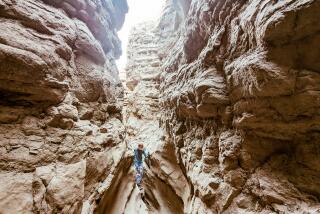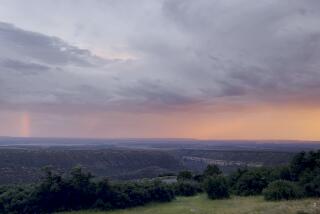An Enjoyable Picnic With Beetles, Lizards
The picnic remains at the top of my list of favorite social gatherings, far surpassing the formal dinner party or anything at which champagne is served. There is something about eating marvelous food in good company under a tree or in an open meadow that delights me.
The other day, Jean Erck and I went on a picnic to Indian Canyons, outside of Palm Springs. She had guests from Aspen, Colo., and she wanted to show them the beauty of the shady canyons.
We had all the requisites for a picnic. Some things are indigenous to picnics and must be served. One of these is deviled eggs. We also had sandwiches on croissants and on French baguettes--ham, turkey, Swiss cheese. We had potato salad, black olives and bread and butter pickles. Dessert was praline cookies and fruit, and we had a tall cooler of iced tea.
We were in Palm Canyon where there are picnic tables and benches under the tall clusters of palm trees. A lot of the trees had scorched and blackened trunks where vandals had set fires under them and the trunks were carved with initials. I suspect that man has done this since he first found a sharp rock and a tree and turned to his friend and said, “Let’s gouge these trees,” but the antiquity of the damage doesn’t make it any more acceptable.
A pickup truck and van were parked close to where we left Jean’s car. The four men and one woman gathered around the vehicles were wearing floppy waders, and there was a thing that looked like a butterfly net with a long handle leaning against the van. They told us they were biologists from the University of Nevada at Las Vegas and Sacramento State University. They were on a week’s exploration looking for a aquatic beetles.
They were camping each night along their way. The young woman, Cheryl Barr, from Sacramento State, showed me a desert spring lizard. It was about seven inches long and iridescent green and purple, looking as if it might have been crafted by Faberge. The body seemed made of hundreds of tiny jewels. Cheryl looked at the lizard and said, “It’s a female,” with total assurance. Cheryl explained that the male has a brilliant blue stomach. Of course. How ostentatious.
Dr. Bill Shepard, also from Sacramento State, said they had had a productive trip, gathering several kinds of aquatic beetles. Dr. Chad Murvosh from the University of Nevada wore a floppy hat Teddy Roosevelt would have loved. The third man was Pete Balfour from Sacramento State and the fourth was a graduate student named Lorne Seidman from University of Nevada.
They were having a fine time gathering beetles in a stream that hurried down the canyon. Dr. Shepard discovered a new beetle in the area where we had our picnic when they were on their field trip last year. “At least, it was a new population for this area.”
They were merry about their bugs and lizards and seemed to be having fun, as any sensible person would, wading around in cool water on a hot day with a blue sky and the palm trees making their rustling sounds overhead.
Palm Canyon is 15 miles long and was one of the canyons that was home to the Cahuilla Indians, who still own 32,000 acres of the desert. They were hunters and gatherers, eating the plants and animals the desert offered in profusion. Andreas and Murray are the names of the other two canyons. Palm and Andreas canyons have the most and the second-most, respectively, fan palm trees in the world, and Murray Canyon has the fourth largest number.
Visitors to the desert hike in the canyons or ride horseback into the dark groves of palm trees.
We went to the top of Palm Canyon and stopped at the trading post where the beautiful grass baskets made by the Cahuillas are for sale. Turquoise and silver jewelry and blankets woven in the soft desert colors are offered too.
It was a lovely picnic day and the beetle people seemed to enjoy it, too.
More to Read
Sign up for The Wild
We’ll help you find the best places to hike, bike and run, as well as the perfect silent spots for meditation and yoga.
You may occasionally receive promotional content from the Los Angeles Times.






